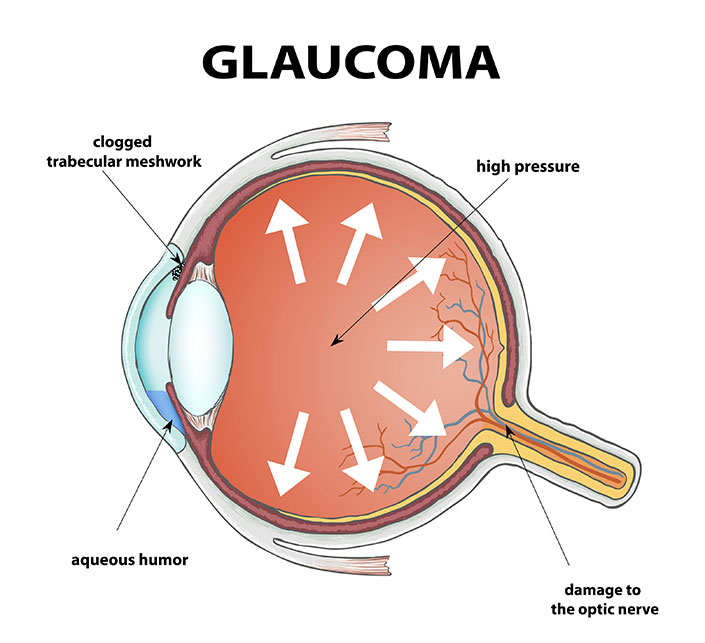Glaucoma
Glaucoma is an eye condition where your optic nerve is damaged causing vision
loss. It is most often linked to intraocular pressure (IOP) buildup in your eye, tends to run in families, and usually occurs later in life.
If left undiagnosed and untreated, glaucoma can result in gradual loss of vision (that you may not notice), and eventually blindness, which is why it is known as the ‘silent thief of sight’.
Cause
The front segment of the eye is filled with a fluid called aqueous humour. This fluid helps maintain normal intraocular pressure. When the production of aqueous humour is increased or its drainage is not adequate, the pressure within the eye builds up and glaucoma develops.
Types of Glaucoma and Symptoms
Primary Open Angle Glaucoma (or chronic glaucoma) – eye pressure rises when drainage of aqueous fluid is decreased because of blockage in the drainage channels. This occurs very gradually, slowly damaging the optic nerve without any warning signs.
Side vision is usually lost first so that this form of glaucoma can go undetected until irreversible damage has occurred and central vision is affected, Sometimes there may be symptoms like mild headaches, vague visual disturbances such as halos around light points and poor adaptation in darkness. Both eyes are usually involved and this is the most common form of glaucoma.
Closed-angle glaucoma
occurs when the drainage angle in the eye begins to close, impeding the normal outflow of aqueous.
Angle-closure glaucoma can be either chronic (there is an anatomically narrow angle or temporary episodes of angle closures over time) or acute (the angle narrows or closes suddenly).
Acute angle closure occurs suddenly and is characterised by severe pain, redness, headache, nausea and vomiting, and sharply reduced vision. Usually only one eye is affected.
Narrow-angle glaucoma often is used to describe glaucoma that occurs when the drainage angle is too small or is partially closed.
Low-tension or normal-tension glaucoma
In these types of glaucoma, optic nerve damage and vision loss occurs even though IOP remains normal. Low blood pressure may be a risk factor.
Congenital glaucoma
Some children are born with a defect in the drainage angle that prevents the aqueous fluid from exiting the eye normally. Usually there are obvious symptoms, such as cloudy corneas and watery eyes.
Secondary glaucoma
This type of glaucoma develops due to complications of certain medical conditions including diabetes and high blood pressure; or because of other eye conditions such as cataracts or eye inflammation; or as a side effect of medications such as steroids, or trauma to the eye.
Risks of Developing Glaucoma
Some people are more likely to develop glaucoma than others. If you have some of these risk factors, you are advised to go for an eye check-up
- Family history of glaucoma
- Over 40 years
- Very long or short sighted
- Previous history of eye injury
- Long term use of eye drops containing steroids or oral steroids
- Have a medical history of diabetes, high blood pressure, heart disease
- Have high eye pressure
Diagnosis
To diagnose glaucoma, we have to perform several tests:
- Eye (intraocular) Pressure measurement
- Gonioscopy (to check the drainage angle of your eye)
- Visual Field Examination and Optical Coherence Tomography - to check your side vision and assess optic nerve damage
- Pachymetry - cornea thickness measurement because this directly affects your pressure readings.
Glaucoma Treatment
Glaucoma is a lifelong eye condition that needs continual follow up and monitoring. It cannot be cured but early detection and proper treatment can protect your eyesight and prevent blindness.
Treatment of open-angle glaucoma requires lowering the eye's pressure by increasing the drainage of aqueous humour fluid or decreasing the production of that fluid. Eye drop medications can accomplish both of these goals. Laser treatments
and surgery are directed at improving the eye's aqueous drainage.
Treatment for angle-closure glaucoma usually involves a laser peripheral iridotomy (making a hole in the iris) to minimise the risk of sudden rise in pressure and damage to the optic nerve. The unaffected eye is usually also treated to prevent a future attack.
Sometimes cataract surgery (when a thickened lens is removed) can also allow the narrow angle to widen up.
It is always important to get your eyes checked regularly, for proper monitoring, keeping in mind that you may still need to continue eye drops even after laser treatment or surgery.
Warning
As there is no cure for glaucoma, the whole aim of treatment is to control the eye pressure to prevent permanent damage and loss of vision. If you lose vision, it can’t be brought back.
Once you are diagnosed with glaucoma, you MUST use any prescribed eye drops consistently and go for your regular check-ups as advised.

